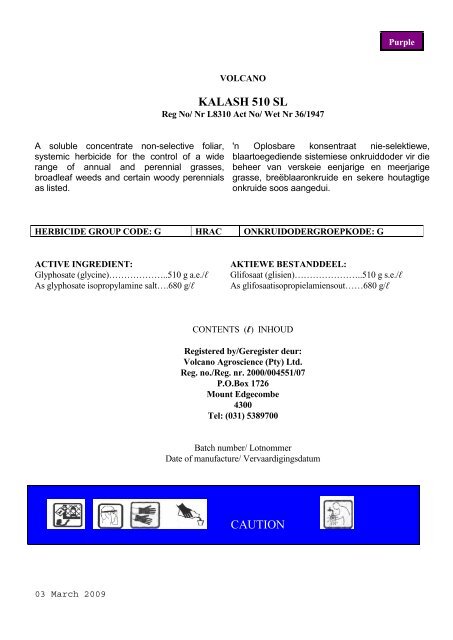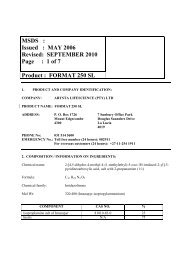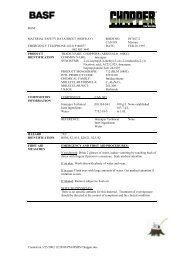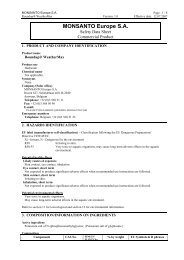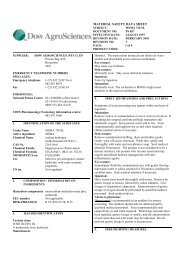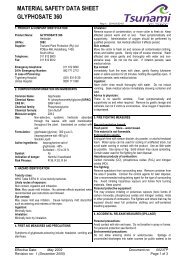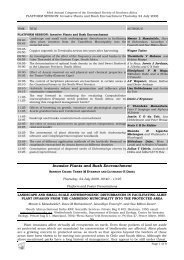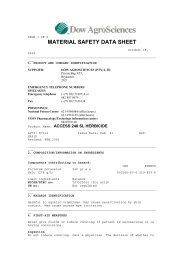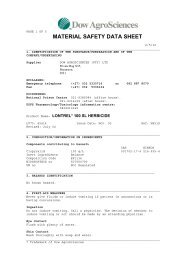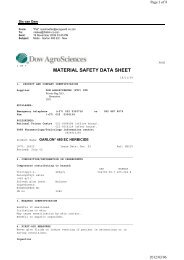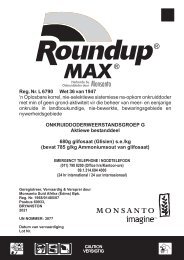KALASH 510 SL CAUTION - Bush Encroachment
KALASH 510 SL CAUTION - Bush Encroachment
KALASH 510 SL CAUTION - Bush Encroachment
You also want an ePaper? Increase the reach of your titles
YUMPU automatically turns print PDFs into web optimized ePapers that Google loves.
A soluble concentrate non-selective foliar,<br />
systemic herbicide for the control of a wide<br />
range of annual and perennial grasses,<br />
broadleaf weeds and certain woody perennials<br />
as listed.<br />
03 March 2009<br />
VOLCANO<br />
<strong>KALASH</strong> <strong>510</strong> <strong>SL</strong><br />
Reg No/ Nr L8310 Act No/ Wet Nr 36/1947<br />
Purple<br />
'n Oplosbare konsentraat nie-selektiewe,<br />
blaartoegediende sistemiese onkruiddoder vir die<br />
beheer van verskeie eenjarige en meerjarige<br />
grasse, breëblaaronkruide en sekere houtagtige<br />
onkruide soos aangedui.<br />
HERBICIDE GROUP CODE: G HRAC ONKRUIDODERGROEPKODE: G<br />
ACTIVE INGREDIENT:<br />
Glyphosate (glycine)………………..<strong>510</strong> g a.e./ℓ<br />
As glyphosate isopropylamine salt….680 g/ℓ<br />
AKTIEWE BESTANDDEEL:<br />
Glifosaat (glisien)…………………..<strong>510</strong> g s.e./ℓ<br />
As glifosaatisopropielamiensout……680 g/ℓ<br />
CONTENTS (ℓ) INHOUD<br />
Registered by/Geregister deur:<br />
Volcano Agroscience (Pty) Ltd.<br />
Reg. no./Reg. nr. 2000/004551/07<br />
P.O.Box 1726<br />
Mount Edgecombe<br />
4300<br />
Tel: (031) 5389700<br />
Batch number/ Lotnommer<br />
Date of manufacture/ Vervaardigingsdatum<br />
<strong>CAUTION</strong><br />
VERSIGTIG
WARNINGS<br />
03 March 2009<br />
2<br />
• Poisonous if swallowed.<br />
• Avoid contact with skin or eyes since product is eye irritant and may cause skin irritation.<br />
• Store away from food and feeds, fertilizers and other chemicals.<br />
• Keep out of reach of children, uninformed persons and animals.<br />
• Do not spray over or allow drift to contaminate water or adjacent areas.<br />
• Aerial application. Notify all inhabitants in the immediate vicinity of the area to be sprayed and<br />
issue the necessary warnings.<br />
• Re-entry. Do not enter treated area until spray deposit has dried unless wearing protective<br />
clothing.<br />
Although this remedy has been extensively tested under a large variety of conditions, the<br />
registration holder does not warrant that it will be efficacious under all conditions because the<br />
action and effect thereof may be affected by factors such as abnormal soil, climatic and storage<br />
conditions, quality of dilution water, compatibility with other substances not indicated on the<br />
label and the occurrence of resistance of the weed against the remedy concerned, as well as<br />
by the method, time and accuracy of application. The registration holder furthermore does not<br />
accept responsibility for damage to crops, vegetation, the environment, or harm to man or<br />
animal or for lack of performance of the remedy concerned due to failure of the user to follow<br />
the label instructions or to the occurrence of conditions which could not have been foreseen in<br />
terms of the registration. Consult the supplier in the event of any uncertainty.<br />
PRE<strong>CAUTION</strong>S<br />
- Do not eat, drink or smoke while handling this product.<br />
- Prevent contamination of food, feeds, drinking water and eating utensils.<br />
- Wash yourself after use or accidental skin contact.<br />
- Change and wash contaminated clothes.<br />
- Do not inhale the spray mist.<br />
- Avoid contact with the spray as much as you can.<br />
- Avoid spray drift onto other crops, grazing, rivers, dams and areas not under treatment.<br />
- Clean applicator thoroughly after use and dispose of wash water where it will not contaminate<br />
crops, grazing, rivers or dams.<br />
- Rinse the container three times with a volume of water equal to a minimum of 10% of the<br />
container. Add the rinsing to the contents of the spray tank. Destroy empty container and do not<br />
use for any other purpose.<br />
RESISTANCE WARNING<br />
For resistance management, <strong>KALASH</strong> <strong>510</strong> <strong>SL</strong> is a group code G herbicide. Any weed population<br />
may contain individual weeds naturally resistant to <strong>KALASH</strong> <strong>510</strong> <strong>SL</strong> and other group code G<br />
herbicides. The resistant individuals can eventually dominate the weed population if these herbicides<br />
are used repeatedly. These resistant weeds may not be controlled by <strong>KALASH</strong> <strong>510</strong> <strong>SL</strong> or any other<br />
group code G herbicide.<br />
In order to delay herbicide resistance:
03 March 2009<br />
3<br />
• Avoid the exclusive and repeated use of herbicides from the same herbicide group<br />
code.<br />
• Alternate or tank mix with products from different herbicide group codes.<br />
• Integrate chemical and cultural control methods into weed control programmes.<br />
For more information on resistance management, contact the registration holder<br />
DIRECTIONS FOR USE: Use only as indicated.<br />
1. Use only clean water in spray mixture.<br />
2. Always ensure that spray equipment is clean, and correctly calibrated before spraying.<br />
3. Use low spray pressure (100 - 200 kPa) to avoid spray drift.<br />
4. <strong>KALASH</strong> <strong>510</strong> <strong>SL</strong> is actively absorbed through immature bark and leaves of most plants and<br />
trees. Contact with immature bark, such as in trees younger than three years, can result in<br />
serious localised or translocated damage. THEREFORE CONTACT WITH LEAVES, GREEN<br />
OR IMMATURE BARK AND FRUIT OF DESIRED PLANTS, WHETHER DIRECT OR BY<br />
SPRAY DRIFT, MUST BE AVOIDED. ALWAYS MAKE SURE THAT ONLY UNDESIRABLE<br />
PLANTS ARE TREATED. Do not spray onto pruned vines or fruit trees until wounds have<br />
sealed properly. <strong>KALASH</strong> <strong>510</strong> <strong>SL</strong> is a non-selective systemic herbicide and is only active when<br />
applied to the green foliage and bark of plants. The visible effect of <strong>KALASH</strong> <strong>510</strong> <strong>SL</strong> on treated<br />
foliage usually appears at 10-14 days after treatment but may vary according to weather<br />
conditions. <strong>KALASH</strong> <strong>510</strong> <strong>SL</strong> should be applied to actively growing weeds that are not dormant<br />
or under temperature or moisture stress. Rain or irrigation a few days prior to an <strong>KALASH</strong> <strong>510</strong><br />
<strong>SL</strong> application ensures that weeds are actively growing, resulting in optimum efficacy. Rain or<br />
irrigation within 6 hours of application can reduce <strong>KALASH</strong> <strong>510</strong> <strong>SL</strong> efficacy. Do not spray on<br />
weed foliage covered with a layer of dust. In these situations apply after recent rain. <strong>KALASH</strong><br />
<strong>510</strong> <strong>SL</strong> has NO pre-emergence activity, therefore repeat applications are necessary (when<br />
applied on its own) to control weeds germinating from seed. Ensure that target weeds are fully<br />
exposed to the <strong>KALASH</strong> <strong>510</strong> <strong>SL</strong> spray.<br />
Use restrictions<br />
When using <strong>KALASH</strong> <strong>510</strong> <strong>SL</strong> as a land preparation for transplanted tomatoes, tobacco or any other<br />
transplanted crop with green and soft stems, allow a minimum of 14 days between application and<br />
transplanting of seedlings.<br />
Mixing instructions<br />
Half fill the spray tank with clean water and add the required quantity of <strong>KALASH</strong> <strong>510</strong> <strong>SL</strong>. Then fill the<br />
tank to the required volume with clean water, ensuring thorough agitation. When using tank mixes, the<br />
additional herbicide should be added after <strong>KALASH</strong> <strong>510</strong> <strong>SL</strong> and agitation must be continuous before<br />
and during spraying.<br />
Application<br />
Remove sediments eg, residues of WP pesticides, from spray tanks before adding <strong>KALASH</strong> <strong>510</strong> <strong>SL</strong>.<br />
Avoid the use of hard or muddy water, or water with a high colloidal content derived from soils high in<br />
organic matter. Correctly calibrate all sprayers under field conditions prior to application. It is not
4<br />
necessary to spray to the point of run-off, but essential to ensure complete coverage of the target<br />
weed. EVEN APPLICATION IS ESSENTIAL FOR GOOD RESULTS.<br />
Ground application<br />
<strong>KALASH</strong> <strong>510</strong> <strong>SL</strong> can be applied with conventional ground equipment (tractor mounted booms,<br />
knapsack etc). Optimum spray deposits are obtained with ground equipment calibrated to spray 30 -<br />
600 ℓ/ha with suitable nozzles to ensure adequate coverage. Where drift is a problem do not exceed<br />
2 Bar. Use only the pressures recommended for specific nozzles to avoid drift.<br />
Aerial application<br />
<strong>KALASH</strong> <strong>510</strong> <strong>SL</strong> can be applied aerially provided that the spray mixture is evenly distributed<br />
over the target area. Aerial application may only be done by an accredited pest control operator<br />
registered in Field (i): Aerial Application (Act No 36 of 1947), using a registered and correctly calibrated<br />
aircraft and applying the spray mixture in accordance with the South African National Standard 10118:<br />
The Aerial Application of Agricultural Remedies. It is important to ensure that the spray mixture is<br />
distributed evenly over the target area and that the loss of spray material during application is<br />
restricted to a minimum. It is therefore essential that the following criteria shall be met.<br />
Equipment<br />
Application parameters<br />
03 March 2009<br />
• Use suitable atomising equipment (hydraulic nozzles or rotary atomisers) that will<br />
produce the desired droplet size and coverage of the target area and will ensure<br />
the minimum loss of spray mixture through drift.<br />
• The operator must use a nozzle set-up that will produce a droplet spectrum with the<br />
lowest possible relative span.<br />
• All nozzles and atomisers should be positioned within the inner 75 % of the<br />
aircraft’s wingspan to prevent droplets from entering the wingtip vortices.<br />
• A minimum volume of 30 ℓ spray mixture per hectare is recommended. As<br />
<strong>KALASH</strong> <strong>510</strong> <strong>SL</strong> has not been evaluated at a reduced application rate, the<br />
registration holder cannot guarantee efficacy nor be held responsible for any<br />
adverse effects if this product is applied aerially at a lower volume rate than<br />
recommended.<br />
• A droplet coverage of 40 to 60 droplets per cm 2<br />
• A droplet spectrum with a VMD of 350 microns is recommended. Ensure that the<br />
production of fine droplets (with a VMD less than 150 microns) is restricted to a<br />
minimum.<br />
must be recovered at the target.<br />
• The height of the spray boom should be maintained at between three and four<br />
metres above the target.<br />
• Do not spray when the aircraft is in a climb, at the top of a turn or during a dive, or<br />
when banking.<br />
• Apply before the crop growth becomes too dense as this will interfere with overall<br />
weed coverage.
Meteorological conditions<br />
General<br />
Application rates<br />
03 March 2009<br />
5<br />
• The difference between the wet and dry bulb thermometer readings as determined<br />
by a whirling hygrometer, must not exceed 8 °C.<br />
• Do not spray under turbulent, unstable conditions nor during the heat of the day<br />
when rising thermals and downdraughts occur.<br />
• Do not spray under temperature inversion conditions, i.e., spraying in or above the<br />
inversion layer.<br />
• Do not spray when the wind speed exceeds 15 km per hour.<br />
• Ensure that fields are accurately marked and that the aerial spray operator knows<br />
exactly which fields to spray.<br />
• Obtain an assurance from the aerial spray operator that the above requirements will<br />
be met.<br />
<strong>KALASH</strong> <strong>510</strong> <strong>SL</strong> will control most emerged annual weeds germinating from seed in situations such as<br />
fallow land, pre-plant of crops, reduced or conservation tillage, perennial vine and tree crops. Apply<br />
the <strong>KALASH</strong> <strong>510</strong> <strong>SL</strong> dosage rate according to the weed growth stage - the higher dosage rates within<br />
the range should be used when the weeds are older and more established in the specific growth<br />
stage.<br />
1 CONTROL OF PERENNIAL WEEDS<br />
1.1 NOXIOUS WEEDS<br />
BOTANICAL<br />
NAME<br />
COMMON<br />
NAME<br />
DOSAGE<br />
RATE<br />
ℓ/ha %<br />
Soln<br />
REMARKS
Sesbania<br />
punicea<br />
Solanum<br />
mauritianum<br />
Acacia dealbata<br />
Mimosa pigra<br />
Chromolaena<br />
odorata<br />
03 March 2009<br />
Red Sesbania<br />
Bugweed<br />
Silver wattle<br />
Giant<br />
sensitive plant<br />
Triffid weed<br />
2,2<br />
1,5<br />
4,3<br />
1,0<br />
1,0<br />
0,4<br />
6<br />
14,4<br />
1.2 GRASSES DOSAGE RATE<br />
BOTANICAL NAME COMMON NAME ℓ/ha % Soln<br />
Cynodon dactylon<br />
Eragrostis curvula<br />
Paspalum dilatatum<br />
Common couch<br />
Weeping love grass<br />
Common Paspalum<br />
0,7<br />
2,2<br />
Seedling plants less than 1 m high: Use 1,0<br />
% solution.<br />
Tall shrubs: Slash, spray re-growth with 1,0-<br />
1,4 % solution at 1 m high.<br />
Apply in spring or summer.<br />
Large trees: Cut to 50 cm, allow new growth<br />
of at least 50 cm before application.<br />
Saplings: Apply directly to foliage.<br />
Summer application. Applied to low cut<br />
stumps, cut 10 cm obove ground level. Freshly<br />
cut stumps must be sprayed to the point of<br />
run-off. Spray must be directed to the<br />
cambrium layer and exposed bark.<br />
Apply to foliar part of seedlings and plants up<br />
to 1 m in height.<br />
Apply in summer and autumn. Slash<br />
established plants and allow to regrow. Spray<br />
when regrowth is between 50 and 120 cm.<br />
Ensure complete coverage of foilage.<br />
Previously slashed multisystem plants may<br />
require a follow up treatment.<br />
4,3<br />
6,5<br />
2,2<br />
4,3<br />
--<br />
--<br />
1,0<br />
2,2<br />
REMARKS<br />
Summer rainfall region:<br />
Apply to active growth in<br />
autumn or summer. If regrowth<br />
occurs, spray with 1,8<br />
% solution.<br />
Winter rainfall region:<br />
As above in autumn.<br />
Apply to active growth in<br />
summer or autumn.<br />
Apply in summer at flower but<br />
before seed drop. If re-growth<br />
occurs, spray with 1,0 %<br />
solution.
1.2 GRASSES (continued) DOSAGE RATE<br />
BOTANICAL NAME COMMON NAME ℓ/ha % Soln<br />
Paspalum paspalodes<br />
Panicum maximum<br />
Pennisetum<br />
clandestinum<br />
Setaria megaphylla<br />
Sorghum halepense<br />
Sorghum<br />
verticilliflorum<br />
03 March 2009<br />
Couch Paspalum<br />
Common buffalo grass<br />
Kikuyu<br />
<strong>Bush</strong> buffalo grass<br />
Johnson grass<br />
Common wild-<br />
Sorghum<br />
7<br />
5,8 -<br />
6,5<br />
4,3<br />
2,9<br />
4,3<br />
2,9<br />
2,2<br />
--<br />
2,2<br />
1,0<br />
2,2<br />
1,5<br />
1,0<br />
REMARKS<br />
Apply in summer at flowering<br />
but before seed drop. If re-<br />
growth occurs, spray with 1,5<br />
% solution or 2,9 ℓ/ha. Apply<br />
the higher rate in the winter<br />
rainfall region.<br />
Apply in summer to actively<br />
growing plants in the early<br />
growth stage. If regrowth<br />
occurs, spray with 1,0 %<br />
solution.<br />
Apply in summer to actively<br />
growing plants. If regrowth<br />
occurs, spray with 1,0 %<br />
solution.<br />
Apply to actively growing plants<br />
in autumn or summer. If<br />
regrowth occurs, spray with 1,0<br />
% solution.<br />
Apply in summer or autumn. If<br />
regrowth occurs, spray with 1,0<br />
% solution.<br />
Apply to actively growing plants<br />
in summer or autumn.
1.3 SEDGES DOSAGE RATE<br />
BOTANICAL NAME COMMON NAME ℓ/ha % Soln<br />
Cyperus esculentus<br />
Cyperus rotundus<br />
03 March 2009<br />
Yellow nutsedge<br />
Purple nutsedge<br />
2 CONTROL OF ANNUAL WEEDS<br />
2.1 Broadleaf weeds<br />
The following broadleaf weeds will be controlled at the rates and growth<br />
stages as indicated below.<br />
8<br />
4,3<br />
4,3<br />
<strong>KALASH</strong> <strong>510</strong> <strong>SL</strong> ℓ/ha<br />
0,7 – 1,5 1,5 2,2<br />
1 – 12 leaf 12 leaf to<br />
pre-bloom<br />
Flowering<br />
Alternanthera pungens Khaki bur weed<br />
Amaranthus hybridus Cape pigweed<br />
Amaranthus spinosus Thorny pigweed<br />
Amaranthus thunbergii Red pigweed<br />
Arctotis venusta Free State daisy<br />
Argemone subfusiformis Mexican poppy<br />
Bidens pilosa Blackjack<br />
Chenopodium album White goosefoot<br />
Chenopodium ambrosioides American goosefoot<br />
Chenopodium carinatum Green goosefoot<br />
Chenopodium murale Nettle-leaved goosefoot<br />
Cirsium arvense Canada thistle<br />
Citrullus lanatus Bitter apple<br />
Conyza albida Tall fleabane<br />
Cucumis spp Wild cucumber<br />
Datura ferox Large thorn apple<br />
Datura stramonium Thorn apple<br />
Galinsoga parviflora Gallant soldier<br />
Gisekia pharnaceoides Gisekia<br />
Gnaphalium subfalcatum Cudweed<br />
Lepidium africanum Pepper cress<br />
Pentzia grandiflora Stinkweed<br />
Physalis angulata Wild gooseberry<br />
Pseudognaphalium luteo-album Jersey cudweed<br />
Richardia brasiliensis Tropical Richardia<br />
--<br />
--<br />
REMARKS<br />
Apply in summer at preflowering<br />
stage. If regrowth<br />
occurs, spray with 1,0 % solution<br />
or 2,2 ℓ/ha. (Best results<br />
in Feb/March).
2.2 Grasses<br />
03 March 2009<br />
9<br />
Spergula arvensis Corn spurry<br />
The following grasses will be controlled at the rates and growth stages as indicated below.<br />
<strong>KALASH</strong> <strong>510</strong> <strong>SL</strong> ℓ/ha<br />
1,0 – 2,2 2,2<br />
1 leaf to pre-bloom<br />
Flowering<br />
Avena fatua Common wild oats<br />
Avena spp Wild oats<br />
Briza maxima Quaking grass<br />
Bromus diandrus Ripgut brome<br />
Ehrharta longifolia Oat-seed grass<br />
Eleusine indica Goose grass<br />
Eragrostis curvula Weeping love grass<br />
Hordeum murinum Wild barley<br />
Lolium multiflorum Italian rye grass<br />
Lolium temulentum Darnel<br />
Panicum schinzii Sweet buffalo grass<br />
Poa annua Winter grass<br />
Rhynchelytrum repens Natal red-top<br />
Secale cereale Rye<br />
Sorghum bicolor Wild grain-Sorghum<br />
Tragus racemosus Large carrot-seed grass
2.3 Broadleaf weeds and grasses<br />
03 March 2009<br />
10<br />
<strong>KALASH</strong> <strong>510</strong> <strong>SL</strong> ℓ/ha<br />
1,0 – 1,5 1,5 – 2,2 2,2 – 2,9<br />
1- 12 leaf 12 leaf to pre-bloom Flowering<br />
Arctotheca calendula Cape marigold<br />
Chamaesyce hirta Red milkweed<br />
Chamaesyce inaequilatera Smooth creeping milkweed<br />
Chloris virgata Feathertop Chloris<br />
Commelina benghalensis Wandering Jew<br />
Conyza canadensis Canadian fleabane<br />
Conyza albida Tall fleabane<br />
Coronopus didymus Swine cress<br />
Crotolaria sphaerocarpa Mealie Crotolaria<br />
Emex australis Spiny emex<br />
Fumaria muralis Fumitory<br />
Hibiscus cannabinus Kenaf<br />
Hibiscus trionum Bladderweed<br />
Ipomoea purpurea Common morning glory<br />
Paspalum urvillei (seedlings) Tall Paspalum<br />
Phalaris minor Little seeded canary grass<br />
Portulaca oleracea Common purslane<br />
Raphanus raphanistrum Wild radish<br />
Schkuhria pinnata Dwarf marigold<br />
Senecio burchellii Molteno-disease Senecio<br />
Sesamum triphyllum Wild sesame<br />
Setaria pallide-fusca Red bristle grass<br />
Setaria verticillata Sticky bristle grass<br />
Sonchus oleraceus Common sowthistle<br />
Tagetes minuta Tall khaki weed<br />
Tribulus terrestris Common dubbeltjie<br />
Veronica spp. Speedwell<br />
Zea mays Volunteer maize<br />
Triticum spp Volunteer wheat
2.4 Broadleaf weeds and grasses<br />
03 March 2009<br />
11<br />
<strong>KALASH</strong> <strong>510</strong> <strong>SL</strong> ℓ/ha<br />
1,8 – 2,2 2,2 – 3,6 3,6 – 4,3<br />
1 – 12 leaf 12 leaf to pre-bloom Flowering<br />
Cleome gynandra Spider-wisp<br />
Digitaria sanguinalis Crab finger-grass<br />
Echinochloa crus-galli Barnyard grass<br />
Echium lycopsis Patterson’s curse<br />
Hypochoeris radicata Hairy wild lettuce<br />
Panicum maximum Common buffalo grass<br />
Paspalum urvillei Tall Paspalum<br />
Plantago lanceolata Narrow-leaved ribwort<br />
Polygonum aviculare Prostate knotweed<br />
Sida cordifolia Heartleaf Sida<br />
Solanum nigrum Nightshade<br />
Urochloa panicoides Garden Urochloa<br />
Verbena officinalis European Verbena<br />
2.5 Broadleaf weeds<br />
2.6 Broadleaf weeds<br />
<strong>KALASH</strong> <strong>510</strong> <strong>SL</strong> ℓ/ha<br />
1,0 – 4,3 4,3 4,3<br />
1 – 12 leaf 12 leaf to pre-bloom Flowering<br />
Erodium moschatum Musk heron’s bill<br />
<strong>KALASH</strong> <strong>510</strong> <strong>SL</strong> ℓ/ha<br />
4,3 4,3 4,3<br />
1 – 12 leaf 12 leaf to pre-bloom Flowering<br />
Malva parviflora Small mallow<br />
Oenothera stricta Evening primrose
2.7 Broadleaf weeds<br />
2.8 Broadleaf weeds<br />
NOTES<br />
03 March 2009<br />
12<br />
<strong>KALASH</strong> <strong>510</strong> <strong>SL</strong> ℓ/ha<br />
3,6 – 4,3 3,6 – 4,3 3,6 – 4,3<br />
1 – 12 leaf 12 leaf to pre-bloom Flowering<br />
Rumex angiocarpus Sheep sorrel<br />
<strong>KALASH</strong> <strong>510</strong> <strong>SL</strong> ℓ/ha<br />
2,9 5,8 2,2 % Solution:<br />
1 – 12 leaf 12 leaf to pre-bloom Flowering<br />
Acacia saligna Port Jackson willow<br />
For Malva parviflora [ small mallow ] and Oenothera stricta [ evening primrose](smaller than 12 leaf<br />
stage) control, spray <strong>KALASH</strong> <strong>510</strong> <strong>SL</strong> at 2,2 ℓ/ha in combination with the recommended simazine<br />
SC rate for the soil type.<br />
For problem Erodium moschatum [ Musk heron’s bill ] ( low growing type ) control in grapevines and<br />
deciduous fruit, apply 1,5 ℓ/ha <strong>KALASH</strong> <strong>510</strong> <strong>SL</strong> prior to budburst. Regrowth must be sprayed 4 to 6<br />
weeks later with paraquat plus simazine SC. Refer to paraquat and simazine SC labels for rates and<br />
details.
3 SPECIFIC RECOMMENDATIONS<br />
03 March 2009<br />
13<br />
CROP REMARKS<br />
3.1 Almonds, Aloes, Apples, Apricots,<br />
Avocados, Bananas, Blackberry,<br />
Cherries, Citrus, Coffee, Granadilla,<br />
Guava, Hops, Kiwi fruit, Litchies,<br />
Macadamia nuts, Mangoes,<br />
Nectarines, Olives, Pawpaw,<br />
Peaches, Pears, Pecan nuts,<br />
Pineapples, Plums, Cactus pear,<br />
Prunes, Quince, Tea.<br />
3.2 Vines and fruit trees.<br />
3.3 Sisal<br />
3.4 Arable land<br />
1. See weed tables for dosage rates of <strong>KALASH</strong><br />
<strong>510</strong> <strong>SL</strong>.<br />
2. Protect young trees with green bark from direct<br />
spray.<br />
Apply before bud burst to vines older than 2 years.<br />
Younger vines with green bark should be<br />
shielded.<br />
Spray should be directed onto weeds.<br />
Do not spray onto pruned vines or fruit trees<br />
until wounds have sealed properly.<br />
CROP COVER DESTRUCTION IN<br />
GRAPEVINES:<br />
Apply <strong>KALASH</strong> <strong>510</strong> <strong>SL</strong> at 1,0 – 2,2 ℓ/ ha. Apply<br />
10 days or more after pruning and before bud<br />
burst.<br />
Applications can be made to nursery and mature<br />
plants.<br />
Use <strong>KALASH</strong> <strong>510</strong> <strong>SL</strong> after harvesting of previous<br />
crop. Do not disturb target plants before 6 hours<br />
after application (before planting of crops) and<br />
prior to emergence of new crop.
3.5 FORESTRY USAGE:<br />
DOSAGE RATE<br />
WEED<br />
SITUATION SPECIES ℓ/ha %<br />
SOLUTION (ℓ<br />
<strong>KALASH</strong> <strong>510</strong><br />
<strong>SL</strong> IN<br />
100 ℓ WATER)<br />
MAINTENANCE<br />
IN ESTAB-<br />
LISHED<br />
FORESTS<br />
1 FIREBREAKS<br />
Firebreaks preparation<br />
either<br />
tracer belts or<br />
total area.<br />
2 BAND PRE-<br />
PARATION FOR<br />
TREE<br />
SEEDLINGS<br />
Situations suitable<br />
for such<br />
treatments include:<br />
a) Virgin veld<br />
b) Clear felled<br />
forests<br />
03 March 2009<br />
Acacia mearnsii<br />
(black wattle)<br />
Solanum<br />
mauritianum<br />
(bugweed)<br />
Rubus spp<br />
(American<br />
bramble)<br />
In both situations<br />
(1 and 2)<br />
weed population<br />
would includeperennials<br />
and annuals.<br />
For list<br />
of some of the<br />
weeds controlled<br />
refer to list.<br />
14<br />
REMARKS<br />
2,2 1,0 Apply to young trees up to 1 m<br />
high.<br />
1,5 1,0<br />
0,4<br />
Large trees: Cut to 50 cm, allow<br />
new growth of at least 50 cm<br />
before application.<br />
Saplings: Apply directly to<br />
foliage.<br />
4,3 2,2 Slash rank growth in winter.<br />
Apply when new growth is more<br />
than 0,5 m high. If regrowth<br />
occurs, spray with 1,0 % solution.<br />
2,9<br />
1,5<br />
A minimum of 200 ℓ spray mix-<br />
ture / ha must be applied when<br />
using the 1,5 % solution.<br />
A follow-up treatment may be<br />
necessary to control some hardy<br />
perennials using a 1,5 % solution<br />
on a spot spray basis.
CROP DOSAGE REMARKS<br />
Eucalyptus grandis<br />
(bluegum)<br />
03 March 2009<br />
3,6 % solution<br />
5 % solution<br />
15<br />
3.6 SUGARCANE LAST RATOON ERADICATION<br />
Minimum tillage.<br />
Single stem stumps: Apply 50 mℓ solution to a<br />
clean cambium area immediately after felling.<br />
Multistem stumps: Apply 100 mℓ solution to a<br />
clean, fully exposed cambium layer immediately after<br />
felling. If regrowth occurs, spray with 1,5 % solution.<br />
CROP DOSAGE REMARKS<br />
Combination tillage.<br />
Spot eradication.<br />
Pre-plant<br />
land preparation.<br />
Spot spraying around<br />
sugarcane field.<br />
July 2007<br />
5,8 – 7,2 ℓ/ha<br />
2,9 – 5,8 ℓ/ha.<br />
7,2 % solution<br />
0,7 – 2,2 ℓ/ha<br />
1,5 % solution.<br />
Allow regrowth after final harvest to grow up to 45<br />
cm – 1,0 m in height [ tillering stage ] , then apply the<br />
spray mixture in 100 – 400 ℓ/ha as a post emergence<br />
spray on the leaves of the tillers.<br />
Use the higher rate on fertile soils where regrowth<br />
might be a problem. Spray the <strong>KALASH</strong> <strong>510</strong> <strong>SL</strong><br />
solution on regrowth of the sugarcane when the<br />
ratoon cane is about 0,35 – 1 m in height. Allow 5 –<br />
10 days application before the cane stool is sheared<br />
at a depth of 10 – 15 cm below soil surface with a<br />
blade shear implement or similar implement.<br />
This treatment will also control certain grasses and<br />
broadleaf weeds. Apply spray solution directly on<br />
cane stools.<br />
Annual weeds: Apply to active growing annual<br />
weeds.<br />
Perrenial weeds: Refer to tables under part 1 for<br />
details.<br />
Direct sprays to active growing plants around field in<br />
problem areas to be cleaned.
WAARSKUWINGS<br />
03 March 2009<br />
16<br />
• Giftig indien ingeneem word.<br />
• Voorkom kontak met vel of oë aangesien produk oog-en velirritasie kan veroorsaak.<br />
• Bewaar weg van voedsel, voer, kunsmis en ander chemikalieë.<br />
• Hou buite bereik van kinders, oningeligte persone en diere.<br />
• Moet nie oor water of aangrensende gebiede spuit of die spuitstof toelaat om dit te<br />
besoedel nie.<br />
• Lugtoediening. Stel al die inwoners in die onmiddellike omgewing van die gebied wat<br />
bespuit gaan word in kennis en reik die nodige waarskuwings uit.<br />
• Herbetreding. Moet nie behandelde gebiede betree alvorend die spuitneerslag droog is<br />
nie tensy beskermende oorklere gedra word.<br />
Alhoewel hierdie middel omvattend onder ’n groot verskeidenheid toestande getoets is, waarborg<br />
die registrasiehouer nie dat dit onder alle toestande doeltreffend sal wees nie aangesien die<br />
werking en effek daarvan beïnvloed kan word deur faktore soos abnormale grond-, klimaats - en<br />
bergingstoestande, kwaliteit van verdunningswater, verenigbaarheid met ander stowwe wat nie<br />
op die etiket aangedui is nie en die voorkoms van weerstand van die onkruid teen die betrokke<br />
middel, sowel as die metode, tyd en akkuraatheid van toediening. Verder aanvaar die<br />
registrasiehouer nie verantwoordelikheid vir skade aan gewasse, plantegroei, die omgewing, of<br />
vir nadelige effek op mens of dier of vir ’n gebrek aan prestasie van die betrokke middel as<br />
gevolg van die versuim van die gebruiker om etiketaanwysings na te kom of as gevolg van die<br />
ontstaan van toestande wat nie kragtens die registrasie voorsien kon word nie. Raadpleeg die<br />
verskaffer in die geval van enige onsekerheid.<br />
VOORSORGMAATREËLS<br />
- Moet nie eet, drink of rook terwyl die produk hanteer word nie.<br />
- Was uself na toediening of per abuise velkontak.<br />
- Trek gekontamineerde klere uit en was dit.<br />
- Moet nie spuitnewel inasem nie.<br />
- Vermy kontak met die spuitstof sover moontlik.<br />
- Vermy oorwaai na ander gewasse, weiding, riviere, damme en gebiede wat nie onder<br />
behandeling is nie.<br />
- Maak spuittoerusting deeglik skoon na gebruik en gooi waswater waar dit nie gewasse,<br />
weiding, riviere of damme sal besoedel nie.<br />
- Spoel die houer driekeer uit met ’n volume water gelykstaande aan ’n minimum van 10%<br />
van die houer. Gooi die spoelwater by die inhoud van die spuittenk. Vernietig leë houer en<br />
moet dit nie vir enige ander doel gebruik nie.<br />
- Vermy besoedeling van voedsel, voer, drinkwater en eetgerei.<br />
WEERSTANDSWAARSKUWING<br />
Vir doeleindes van weerstandbestuur, is <strong>KALASH</strong> <strong>510</strong> <strong>SL</strong> ’n groepkode G onkruiddoder. Enige<br />
bevolking onkruide kan sommige onkruide bevat wat natuurlik weerstandbiedend is teen<br />
<strong>KALASH</strong> <strong>510</strong> <strong>SL</strong> en ander groepkode G onkruiddoders. Indien hierdie groepkode<br />
onkruiddoders herhaaldelik toegedien word, kan die weerstandbiedende individue uiteindelik die
17<br />
bevolking oorheers. Hierdie weerstandbiedende onkruide sal waarskynlik nie deur <strong>KALASH</strong> <strong>510</strong><br />
<strong>SL</strong> of enige ander groepkode G onkruiddoder beheer word nie.<br />
Ten einde weerstand teen onkruiddoders te vertraag:<br />
• Vermy die uitsluitlike en herhaaldelike gebruik van onkruiddoders behorende tot dieselfde<br />
groepkode.<br />
• Wissel af met, of gebruik tenkmengsels van middels van verskillende onkruiddoder<br />
groepkodes.<br />
• Integreer chemiese middels en verbouingspraktyke in onkruidbeheerprogramme.<br />
Vir meer inligting oor weerstandsbestuur raadpleeg die registrasiehouer<br />
GEBRUIKSAANWYSINGS: gebruik slegs soos aangedui.<br />
1. Gebruik slegs skoon water vir spuitmengsel.<br />
2. Maak altyd seker dat spuitapparaat skoon, vry van afsaksels, ens. is en korrek gekalibreer<br />
is voordat bespuit word.<br />
3. Gebruik lae spuitdruk (100 - 200 kPa) om die vorming en wegwaai van spuitnewel te<br />
voorkom.<br />
4. <strong>KALASH</strong> <strong>510</strong> <strong>SL</strong> word geabsorbeer deur onvolwasse bas en die blare van meeste plante<br />
en bome. Kontak met dele wat nie volwasse bas op die hoofstam het nie, soos bome<br />
jonger as drie jaar kan ernstige gelokaliseerde en getranslokeerde skade veroorsaak.<br />
DAAROM MOET KONTAK MET BLARE, GROEN OF ONVOLWASSE BAS EN VRUGTE<br />
DEUR DIREKTE KONTAK OF SPUITNEWEL VERMY WORD. MAAK ALTYD SEKER<br />
DAT <strong>SL</strong>EGS ONGEWENSTE PLANTE BESPUIT WORD. Moet nie toedien in gesnoeide<br />
wingerde en vrugtebome voordat die snoeiwonde behoorlik geseël het nie. <strong>KALASH</strong> <strong>510</strong><br />
<strong>SL</strong> is ’n nie-selektiewe sistemiese onkruiddoder wat slegs aktief is indien dit op die blare en<br />
groen bas van plantegroei toegedien word. Die sigbare effek van <strong>KALASH</strong> <strong>510</strong> <strong>SL</strong> op<br />
behandelde plantegroei is gewoonlik 10-14 dae na behandeling sigbaar maar kan wissel<br />
afhangende van weerstoestande. Gebruik <strong>KALASH</strong> <strong>510</strong> <strong>SL</strong> op aktief groeiende plante wat<br />
nie rustend of onder temperatuur- of vogstremming verkeer nie. Reën of besproeiïng ’n<br />
paar dae voor ’n behandeling, verseker dat die onkruid aktief groei en dat onkruidbeheer<br />
optimaal is. Reën of besproeiing binne 6 uur na behandeling kan die doeltreffenheid<br />
verminder. Moet nie op swaar stofbedekte onkruidblare toedien nie. Dien <strong>KALASH</strong> <strong>510</strong><br />
<strong>SL</strong> in hierdie geval slegs toe nadat stof deur reën afgewas is. Aangesien <strong>KALASH</strong> <strong>510</strong> <strong>SL</strong><br />
geen vooropkoms aktiwiteit op onkruide het nie, sal herhaalde toedienings nodig wees<br />
(wanneer alleen toegedien) om seisoenlange beheer te verseker. Verseker dat<br />
teikenonkruide volledig blootgestel word aan die bespuiting.<br />
Gebruiksbeperkings<br />
Wanneer <strong>KALASH</strong> <strong>510</strong> <strong>SL</strong> gebruik word as ’n land voorberei word en saailinge word daarin<br />
uitgeplant soos tamaties, tabak of enige ander gewas waarvan die stammetjie groen en sag is,<br />
moet ‘n minimum periode van 14 dae verloop tussen bespuiting en die uitplant van die saailinge.<br />
03 March 2009
Menginstruksies<br />
03 March 2009<br />
18<br />
Maak die spuittenk halfvol met skoon water. Voeg die korrekte hoeveelheid <strong>KALASH</strong> <strong>510</strong> <strong>SL</strong><br />
by. Maak die tenk met skoon water vol tot by die verlangde volume. Roer deeglik. In geval van<br />
tenkmengsels, moet die bykomende onkruiddoder na <strong>KALASH</strong> <strong>510</strong> <strong>SL</strong> in die tenk bygevoeg<br />
word en aanhoudend geroer word tydens toediening.<br />
Toediening<br />
Maak altyd seker dat spuittoerusting skoon en vry van roesplekke en stof is. Verwyder aan-<br />
paksels bv. reste van benatbare poeiers in spuittenks voor gebruik. Voorkom die gebruik van<br />
modderige of brak water wat ’n hoë kolloïdale inhoud het wat afkomstig is van grond met ’n hoë<br />
organiese materiaalinhoud. Spuittoerusting moet akkuraat onder veldtoestande gekalibreer<br />
word voor toediening. Dit is nie nodig om <strong>KALASH</strong> <strong>510</strong> <strong>SL</strong> toe te dien tot die punt van afloop<br />
nie maar 'n egalige eweredige plantbedekking is noodsaaklik. EGALIGE TOEDIENING IS<br />
NOODSAAKLIK VIR GOEIE RESULTATE.<br />
Grondtoediening<br />
<strong>KALASH</strong> <strong>510</strong> <strong>SL</strong> kan deur middel van konvensionele grondspuittoerusting (trekker gemonteerde<br />
balke, rugsakspuit) toegedien word. Grondspuittoerusting met geskikte spuitpunte wat ’n<br />
bespuitingsvolume van 30-600 ℓ/ha gee, word aanbeveel vir optimale bedekking. Waar<br />
spuitstofwegdrywing ’n probleem is, moet die druk nie 2 bar oorskry nie. Om spuitstofwegdrywing<br />
te voorkom moet teen ’n druk soos aanbeveel vir ’n spesifieke spuitpunt, gespuit word.<br />
Lugtoediening<br />
<strong>KALASH</strong> <strong>510</strong> <strong>SL</strong> kan met 'n vliegtuig toegedien word mits die spuitmengsel eweredig oor<br />
die teikengebied versprei word. Lugtoediening mag slegs gedoen word deur ’n goedgekeurde<br />
plaagbeheeroperateur geregistreer in Veld (i): Lugtoediening (Wet No 36 van 1947), en wat ’n<br />
geregistreerde en korrek gekalibreerde vliegtuig gebruik en wat die spuitmengsel toedien in<br />
ooreenstemming met Suid-Afrikaanse Nasionale Standaard 10118: Die Lugtoediening van<br />
Landboumiddels. Dit is belangrik om te verseker dat die spuitmengsel eweredig oor die<br />
teikengebied versprei word en dat die verlies van spuitmensel tydens toediening tot ’n minimum<br />
beperk word. Dit is dus noodsaaklik dat die volgende vereistes nagekom word.<br />
Toerusting<br />
• Gebruik geskikte verstuiwingstoerusting (hidroliese spuitneuse of wentelende spuitkoppe)<br />
wat die vereiste druppelgrootte en bedekking van die teikengebied sal lewer en wat die<br />
minste verlies van spuitmengsel deur wegdrywing sal verseker.<br />
• Die toediener moet ‘n stelsel van spuitneuse gebruik wat ‘n druppelspektrum met die<br />
kleinste moontlike relatiewe spanwydte sal lewer.
03 March 2009<br />
19<br />
• Al die spuitneuse en spuitkoppe moet binne 75 % van die vliegtuig se vlerkspan geplaas<br />
word om die beweging van druppels in die vlerkpunte se warreling te beperk.<br />
Toedieningsvereistes<br />
• Minstens 30 ℓ spuitmengsel per hektaar word aanbeveel. Aangesien <strong>KALASH</strong> <strong>510</strong> <strong>SL</strong> nie<br />
teen ‘n laer toedieningsvolume getoets is nie, kan die registrasiehouer nie effektiwiteit<br />
waarborg of verantwoordelik gehou word vir enige nadelige effek indien <strong>KALASH</strong> <strong>510</strong><br />
<strong>SL</strong> teen ‘n laer volume toegedien word tydens lugtoediening as wat hier aanbeveel is<br />
nie.<br />
• ‘n Druppelbedekking van 40 tot 60 druppels per vierkante sentimeter moet op die teiken<br />
herwin word.<br />
• ‘n Druppelspektrum met ‘n VMD van 350 mikron word aanbeveel. Verseker dat die lewer<br />
van fyn druppels (met ‘n VMD wat kleiner is as 150 mikron) tot ‘n minimum beperk word.<br />
• Die spuitbalk moet op ‘n hoogte van drie tot vier meter bokant die teiken gehandhaaf word.<br />
• Moet nie spuit wanneer die vliegtuig klim, aan die bopunt van ‘n draai is of tydens ‘n duik, of<br />
in skuinsvlug is nie.<br />
• Dien toe voordat die gewas te welig groei aangesien die bedekking van die onkruid<br />
verminder sal word.<br />
Meteorologiese toestande<br />
• Die verskil in die lesings van die nat- en droëboltermometerlesings soos bepaal met ‘n<br />
swaaihigrometer, moet nie 8 °C oorskry nie.<br />
• Moenie tydens onstuimige, onstabiele weerstoestande of gedurende die hitte van die dag<br />
toedien wanneer stygende en dalende konveksiestrome voorkom nie.<br />
• Moenie toedien tydens omgekeerde temperatuurtoestande nie, d.w.s., toediening in of<br />
bokant die inversielaag.<br />
• Moenie toedien indien die windspoed 15 km/uur oorskry nie.<br />
Algemeen<br />
• Sorg dat die lande akkuraat gemerk is en die lugtoediener presies weet watter lande<br />
gespuit moet word.<br />
• Verkry versekering van die lugtoediener dat aan die bogenoemde vereistes voldoen sal<br />
word.<br />
Toedieningshoeveelhede<br />
<strong>KALASH</strong> <strong>510</strong> <strong>SL</strong> sal die meeste eenjarige onkruide wat van saad ontkiem, naopkoms beheer in<br />
situasies soos onbewerkte landerye, voor plant van gewasse, verminderde of deklaagbewerking,<br />
meerjarige wingerd- en boomgewasse en in industriële gebiede.<br />
Dien <strong>KALASH</strong> <strong>510</strong> <strong>SL</strong> volgens die groeistadium van onkruide toe. Gebruik die hoër dosis<br />
aanbevelings in die reeks vir ouer en meer gevestigde onkruide in die spesifieke groeistadium.
1. BEHEER VAN MEERJARIGE ONKRUIDE<br />
1.1 SKADELIKE ONKRUIDE<br />
BOTANIESE<br />
NAAM<br />
Sesbania punicea<br />
Solanum<br />
mauritianum<br />
Acacia dealbata<br />
Mimosa pigra<br />
Chromolaena<br />
odorata<br />
03 March 2009<br />
GEWONE<br />
NAAM<br />
Rooi-<br />
Sesbania<br />
Luisbos<br />
Silwerwattel<br />
Reuse<br />
sensitiewe<br />
plant<br />
Paraffienbo<br />
s<br />
DOSIS<br />
20<br />
ℓ/ha % Op-<br />
lossing<br />
2,2<br />
1,5<br />
4,3<br />
1,0<br />
1,0<br />
0,4<br />
14,4<br />
2,2<br />
0,7<br />
OPMERKINGS<br />
Saailingplante kleiner as 1 m hoog:<br />
Gebruik 'n 1,0 % oplossing.<br />
Groot struike: Sny en spuit hergroei<br />
met 'n 1,0 – 1,4 % oplossing wanneer<br />
1 m hoog.<br />
Dien toe in lente of somer.<br />
Groot bome: Sny tot 50 cm, laat<br />
nuwe groei van ten minste 50 cm toe<br />
voor toediening.<br />
Klein boompies: Dien direk op die<br />
blare toe.<br />
Dien toe gedurende die somer. Spuit<br />
op nuut laag afgesnyde stompe bo<br />
die grondoppervlakte. Die stompe<br />
moet ongeveer 10 cm bo grond<br />
oppervlakte afgesny word. Die<br />
stompe moet bespuit word met die<br />
oplossing to by die punt van afloop.<br />
Spuit die lower van die saailinge en<br />
plante tot 1 m in hoogte.<br />
Dien toe gedurende die somer en<br />
herfs. Kap gevestige plante af en laat<br />
toe om te hergroei. Toediening moet<br />
plaasvind wanneer die hergroei<br />
tussen 50 en 120 cm is. Verseker<br />
volledige blaarbedekking. Voorheen<br />
gekapte meerstammige plante mag ’n
03 March 2009<br />
21<br />
opvolg behandeling benodig.<br />
1.2 GRASSE DOSIS OPMERKINGS<br />
Cynodon dactylon<br />
Eragrostis curvula<br />
Paspalum<br />
dilatatum<br />
Paspalum<br />
paspalodes<br />
Panicum maximum<br />
Pennisetum<br />
clandestinum<br />
Setaria megaphylla<br />
Sorghum<br />
halepense<br />
Sorghum<br />
verticilliflorum<br />
GEWONE NAAM ℓ/ha % Op-<br />
lossing<br />
Gewone<br />
kweekgras<br />
Oulandsgras<br />
Gewone<br />
Paspalum<br />
Kweek –<br />
Paspalum<br />
Gewone<br />
buffelsgras<br />
Kikoejoe<br />
Bosbuffelsgras<br />
Johnsongras<br />
Gewone<br />
wildesorghum<br />
4,3<br />
6,5<br />
2,2<br />
4,3<br />
5,8-<br />
6,5<br />
4,3,<br />
2,9<br />
4,3<br />
2,9<br />
2,2<br />
1,0<br />
2,2<br />
2,2<br />
1,5<br />
--<br />
--<br />
--<br />
1,0<br />
2,2<br />
1,0<br />
Somerreënvalgebied:<br />
Dien toe in herfs of somer op aktief<br />
groeiende plante. Indien hergroei<br />
voorkom spuit met 1,8 % oplossing.<br />
Winterreënvalgebied:<br />
Dien toe soos bo in herfs.<br />
Dien toe op aktief groeiende plante in<br />
somer of herfs.<br />
Dien toe in somer tydens blom maar<br />
voor saadval. Indien hergroei<br />
voorkom spuit met 1,0 % oplossing.<br />
Dien toe in somer tydens blom maar<br />
voor saadval. Indien hergroei<br />
voorkom spuit met 'n 1,5 % oplossing<br />
of 2,9 ℓ/ha. Gebruik die hoër dosis in<br />
die winterreënvalgebied<br />
Dien toe in somer op aktief groeiende<br />
plante wat nog in die vroeë<br />
ontwikkeling stadium is. Indien<br />
hergroei voorkom, spuit met 'n 1,5 %<br />
oplossing.<br />
Dien toe in somer op aktief groeiende<br />
plante. Indien hergroei voorkom<br />
spuit met 1,0 % oplossing.<br />
Dien toe in herfs of somer op<br />
aktiefgroeiende plante. Indien<br />
hergroei voorkom spuit met 'n 1,0 %<br />
oplossing.<br />
Dien toe in somer of herfs. Indien<br />
hergroei voorkom spuit met 1,0 %<br />
oplossing.<br />
Dien toe op aktief groeiende plante in<br />
somer of herfs.
03 March 2009<br />
1.3 UINTJIES<br />
22<br />
DOSIS<br />
BOTANIESE NAAM GEWONE NAAM ℓ/ha % Op-<br />
lossing<br />
Cyperus esculentus<br />
Cyperus rotundus<br />
Geeluintjie<br />
Rooiuintjie<br />
2 BEHEER VAN EENJARIGE ONKRUIDE<br />
4,3<br />
4,3<br />
---<br />
---<br />
OPMERKINGS<br />
Dien toe in somer voor<br />
blomstadium. Indien hergroei<br />
voorkom spuit met 1,0 %<br />
oplossing of 2,2 ℓ/ha (beste<br />
resultate in Feb / Maart).<br />
2.1 Breëblaaronkruide. Die volgende breëblaaronkruide sal beheer word teen die dosisse en<br />
groeistadiums soos hieronder aangedui.<br />
<strong>KALASH</strong> <strong>510</strong> <strong>SL</strong> ℓ/ha<br />
0,7 – 1,5 1,5 2,2<br />
1 – 12- blaar 12- blaar tot<br />
voorblom<br />
Alternanthera pungens Kakiedubbeltjie<br />
Amaranthus hybridus Kaapse misbredie<br />
Amaranthus spinosus Doringmisbredie<br />
Amaranthus thunbergii Rooimisbredie<br />
Arcototis venusta Witgousblom<br />
Argemone subfusiformis Witblom bloudissel<br />
Bidens pilosa Knapsekêrel<br />
Chenopodium album Withondebossie<br />
Chenopodium ambrosioides Kruiehondebossie<br />
Chenopodium carinatum Groenhondebossie<br />
Chenopodium murale Muurhondebossie<br />
Cirsium arvense Kanada-dissel<br />
Citrullus lanatus Karkoer<br />
Conyza albida Vaalskraalhans<br />
Cucumis spp Wildekomkommer<br />
Datura ferox Grootstinkblaar<br />
Datura stramonium Stinkblaar<br />
Gnaphalium subfalcatum Roerkruid<br />
Galinsoga parviflora Knopkruid<br />
Blom
2.2 Grasse<br />
03 March 2009<br />
23<br />
Gisekia pharnaceoides Gisekia<br />
Lepidium africanum Peperbossie<br />
Pentzia grandiflora Stinkkruid<br />
Physalis angulata Wilde appelliefie<br />
Pseudognaphalium luteo-album Groenbossie<br />
Richardia brasiliensis Tropiese Richardia<br />
Spergula arvensis Sporrie<br />
Die volgende grasse sal beheer word teen die dosisse en groeistadiums soos hieronder<br />
aangedui:<br />
<strong>KALASH</strong> <strong>510</strong> <strong>SL</strong> ℓ/ha<br />
1,0 – 2,2 2,2<br />
1 blaar tot voor blom<br />
Blom<br />
Avena fatua Gewone wildehawer<br />
Avena spp Wildehawer<br />
Briza maxima Bewertjies<br />
Bromus diandrus Predikantsluis<br />
Ehrharta longifolia Hawersaadgras<br />
Eleusine indica Jongosgras<br />
Eragrostis curvula Oulandegras<br />
Hordeum murinum Wildegars<br />
Lolium multiflorum Italiaanse raaigras<br />
Lolium temulentum Drabok<br />
Panicum schinzii Soetbuffelsgras<br />
Poa annua Wintergras<br />
Rhynchelytrum repens Natalse rooipluim<br />
Secale cereale Rog<br />
Sorghum bicolor Wilde graansorghum<br />
Tragus racemosus Grootwortelsaadgras
2.3 Breëblaaronkruide en grasse<br />
03 March 2009<br />
24<br />
<strong>KALASH</strong> <strong>510</strong> <strong>SL</strong> ℓ/ha<br />
1,0 – 1,5 1,5 – 2,2 2,2 – 2,9<br />
1- 12 blaar 12 blaar tot voor blom Blom<br />
Arctotheca calendula Soetgousblom<br />
Chamaesyce hirta Rooimelkbossie<br />
Chamaesyce inaequilatera Gladdekruipmelkkruid<br />
Chloris virgata Witpluim Chloris<br />
Commelina benghalensis Wandelende Jood<br />
Conyza canadensis Kanadese skraalhans<br />
Conyza albida Vaalskraalhans<br />
Coronopus didymus Peperkruid<br />
Crotolaria sphaerocarpa Mielie Crotolaria<br />
Emex australis Kaapse dubbeltjie<br />
Fumaria muralis Duiwelkerwel<br />
Hibiscus cannabinus Wildestokroos<br />
Hibiscus trionum Terblansbossie<br />
Ipomoea purpurea Purperwinde<br />
Paspalum urvillei (seedlings) Langbeen Paspalum<br />
Portulaca oleracea Gewone porselein<br />
Raphanus raphanistrum Ramenas<br />
Phalaris minor Kleinsaadkanariegras<br />
Schkuhria pinnata Kleinkakiebos<br />
Senecio burchellii Geelgifbossie<br />
Sesamum triphyllum Wildesesam<br />
Setaria pallide-fusca Rooiborselgras<br />
Setaria verticillata Klitsborselgras<br />
Sonchus oleracaeus Gewone sydissel<br />
Tagetes minuta Langkakiebos<br />
Tribulus terrestris Dubbeltjie<br />
Veronica spp. Veronica<br />
Zea mays Opslag mielies<br />
Triticum spp Opslag koring
2.4 Breëblaaronkruide en grasse<br />
03 March 2009<br />
25<br />
<strong>KALASH</strong> <strong>510</strong> <strong>SL</strong> ℓ/ha<br />
1,8 – 2,2 2,2 – 3,6 3,6 – 4,3<br />
1 – 12 blaar 12 blaar tot voor blom Blom<br />
Cleome gynandra Snotterbelletjies<br />
Digitaria sanguinalis Kruisvingergras<br />
Echinochloa crus-galli Hanepootmanna<br />
Echium lycopsis Pers-Echium<br />
Hypochoeris radicata Skaapslaai<br />
Panicum maximum Gewone buffelsgras<br />
Paspalum urvillei Langbeen Paspalum<br />
Plantago lanceolata Kleintongblaar<br />
Polygonum aviculare Voëlduisendknoop<br />
Sida cordifolia Hartblaartaaiman<br />
Solanum nigrum Nastergal<br />
Urochloa panicoides Tuin Urochloa<br />
Verbena officinialis Europese Verbena<br />
2.5 Breëblaaronkruide<br />
<strong>KALASH</strong> <strong>510</strong> <strong>SL</strong> ℓ/ha<br />
1,0 – 4,3 4,3 4,3<br />
1 – 12 blaar 12 blaar tot voor blom Blom<br />
Erodium moschatum Turknael<br />
2.6 Breëblaaronkruide<br />
<strong>KALASH</strong> <strong>510</strong> <strong>SL</strong> ℓ/ha<br />
4,3 4,3 4,3<br />
1 – 12 blaar 12 blaar tot voor blom Blom<br />
Malva parviflora Kiesieblaar<br />
Oenothera stricta Nagblom
2.7 Breëblaaronkruide<br />
03 March 2009<br />
26<br />
<strong>KALASH</strong> <strong>510</strong> <strong>SL</strong> ℓ/ha<br />
3,6 – 4,3 3,6 – 4,3 3,6 – 4,3<br />
1 – 12 blaar 12 blaar tot voor blom Blom<br />
Rumex angiocarpus Steenboksuring<br />
2.8 Breëblaaronkruide<br />
NOTAS<br />
<strong>KALASH</strong> <strong>510</strong> <strong>SL</strong> ℓ/ha<br />
2,9 5,8 2,2 % oplossing<br />
1 – 12 blaar 12 blaar tot voor blom Blom<br />
Acacia saligna Goudwilger<br />
Vir die beheer van Malva parviflora [ kiesieblaar ] en Oenothera stricta [ nagblom ] [ kleiner as 12<br />
blaar stadium ] , spuit <strong>KALASH</strong> <strong>510</strong> <strong>SL</strong> teen 2,2 ℓ/ha in kombinasie met Simasien SC teen die<br />
aanbevole dosis vir die grondsoort.<br />
Vir die beheer van Erodium moschatum [ Turknael ] [laaggroeiende biotipe ] in wingerde en<br />
sagtevrugte dien 1,5 ℓ/ha <strong>KALASH</strong> <strong>510</strong> <strong>SL</strong> voor bot toe. Hergroei moet 4 tot 6 weke later met<br />
paraquat plus simasien SC gespuit word. Verwys na die paraquat en simasien SC etikette vir<br />
hoeveelhede en aanbevelingsinligting.<br />
3 SPESIFIEKE AANBEVELINGS<br />
GEWAS OPMERKINGS<br />
3.1 Amandels, Aalwyn, Appels, Appelkose,<br />
Avokados, Piesangs, Swartbessie,<br />
kersies, Sitrus, Koffie, Grenadella,<br />
Koejawels, Hops, Kiwi-vrug, Lietstjies,<br />
Makadamianeute, Mango's, Nektariens,<br />
Olywe,Papaja, Perskes, Pere,<br />
Pekanneute, Pynappels, Pruime,<br />
Turksvy, Pruimedante, Kweper, Tee.<br />
3.2 Wingerde en vrugtebome.<br />
1. Verwys na onkruidtabelle vir dosisse van<br />
<strong>KALASH</strong> <strong>510</strong> <strong>SL</strong>.<br />
2. Beskerm jong bome met groen bas van<br />
direkte bespuiting.<br />
Dien toe voor bot op wingerde ouer as 2 jaar.<br />
Jonger wingerde en bome met groen bas
3.3 Sisal<br />
3.4 Bewerkte lande<br />
3.5 BOSBOU GEBRUIKE:<br />
DOSIS<br />
ONKRUID-<br />
SITUASIE SPESIE ℓ/ha %<br />
OPLOSSING (ℓ<br />
<strong>KALASH</strong> <strong>510</strong><br />
<strong>SL</strong> IN<br />
100 ℓ WATER)<br />
ONKRUIDBE-<br />
HEER IN GE-<br />
VESTIGDE<br />
PLANTASIES<br />
1 VOORBRAN-<br />
DE<br />
Die voorberei-<br />
03 March 2009<br />
Acacia mearnsii<br />
(swartwattel)<br />
Solanum<br />
mauritianum<br />
(luisbos)<br />
Rubus spp.<br />
(braam)<br />
In beide situa-<br />
sies (1 en 2) sal<br />
27<br />
moet afgeskerm word. Rig bespuiting na<br />
onkruide<br />
Moet nie toedien in gesnoeide wingerde of<br />
vrugtebome voordat die snoeiwonde be-<br />
hoorik geseël het nie.<br />
DEKGEWASVERNIETIGING IN<br />
WINGERDE:<br />
Dien <strong>KALASH</strong> <strong>510</strong> <strong>SL</strong> toe teen 1,0 - 2,2 ℓ/ha.<br />
Dien toe 10 dae of langer na snoei maar voor<br />
bot.<br />
Toedienings kan in kwekery en volwasse<br />
plante gedoen word.<br />
Gebruik <strong>KALASH</strong> <strong>510</strong> <strong>SL</strong> na-oes van vorige<br />
gewas. Moet nie teikenplante voor 6 ure na<br />
toediening versteur nie( voor plant van<br />
gewasse) en voordat nuwe gewasse<br />
opgekom het.<br />
OPMERKINGS<br />
2,2 1,0 Dien toe op jong bome tot en<br />
met 1,0 m hoog.<br />
1,5 1,0<br />
0,4<br />
Groot bome: Sny tot 50<br />
cm, laat nuwe groei van ten<br />
minste 50 cm toe voor<br />
toediening.<br />
Klein boompies: Dien direk<br />
op die blare toe.<br />
4,3 2,2 Sny rankgroei in winter. Dien<br />
toe wanneer nuwe groei<br />
meer as 0,5 m hoog is.<br />
Indien hergroei voorkom,<br />
spuit met 'n 1,5 % oplossing.<br />
2,9<br />
1,5<br />
'n Minimum spuitmengsel<br />
van 200 /ha moet toegedien
ding van 'n algehelebrandbaan<br />
of<br />
brandstroke.<br />
03 March 2009<br />
die onkruid<br />
populasie<br />
bestaan uit<br />
beide een-<br />
jarige en meer-<br />
jarige onkruide<br />
Vir sommige<br />
van die onkruide<br />
wat beheer<br />
word, verwys<br />
na onkruidlys.<br />
3.5 BOSBOU GEBRUIKE (vervolg):<br />
DOSIS<br />
ONKRUID-<br />
SITUASIE SPESIE ℓ/ha %<br />
OPLOSSING (ℓ<br />
<strong>KALASH</strong> <strong>510</strong><br />
<strong>SL</strong> IN<br />
100 ℓ WATER)<br />
2 BAAN VOOR-<br />
BEREIDING VIR<br />
BOOMSAAI-<br />
LINGE<br />
Situasies geskik<br />
vir bogemelde<br />
toedienings sluit<br />
in:<br />
a) Natuurlike of<br />
onversteurde<br />
veld<br />
b) Hervestiging<br />
van plan-<br />
tasie na af<br />
kap van<br />
bome.<br />
Eucalyptus grandis<br />
(bloekomboom)<br />
28<br />
word wanneer die 1,5 %<br />
spuitoplossing gebruik word.<br />
'n Opvolgbespuiting mag<br />
nodig wees om hergroei van<br />
sommige hardnekkige<br />
meerjarige onkruide te beheer.<br />
Gebruik 'n 1,5 % oplossing<br />
op 'n kolbespuitingsbasis.<br />
OPMERKINGS<br />
2,9 1,5 ’n Minimum spuitmengsel<br />
van 200 ℓ/ha moet toegedien<br />
word wanneer die 1,5 %<br />
spuitoplossing gebruik word.<br />
’n Opvolg bespuiting mag<br />
nodig wees om hergroei van<br />
sommige hardnekkige<br />
meerjarige onkruide te<br />
beheer. Gebruik ’n 1,5 %<br />
oplossing om kolbespuiting<br />
te doen.<br />
GEWAS DOSIS OPMERKINGS<br />
3,6 % oplossing<br />
Enkelstam stompe: Dien 50 mℓ oplossing<br />
toe op 'n kaal kambium-area<br />
onmiddellik na afkap.
03 March 2009<br />
29<br />
5,0 % oplossing<br />
3.6 LAASTE OORSTAAN SUIKERRIET VERNIETIGING<br />
Meerstammige stompe: Dien 100 mℓ<br />
oplossing toe op 'n kaal ten-volle<br />
blootgestelde kambiumlaag onmiddellik<br />
na afkap. Indien hergroei voorkom<br />
spuit met 'n 1,5 % oplossing.<br />
GEWAS DOSIS OPMERKINGS<br />
Mimimumbewerking.<br />
Kombinasie<br />
bewerking.<br />
Kol vernietiging.<br />
Voorplant land<br />
voorbereiding.<br />
Kol bespuiting buite<br />
geplante land.<br />
5,8 - 7,2 ℓ/ha<br />
2,9 – 5,8 ℓ/ha<br />
7,2 % oplossing<br />
0,7 – 2,2 ℓ/ha<br />
1,5 % oplossing.<br />
Laat hergroei plaasvind tot ’n hoogte van 0,45<br />
– 1,0 m in hoogte [ spruitvorming statium ]<br />
voordat ‘n spuitoplossing van 100 – 400 ℓ/ha<br />
toegedien word as ‘n naopkom bespuiting op<br />
die suikerrietblare.<br />
Gebruik die hoër dosis op gronde wat<br />
vrugbaar is en waar moontlike hergroei mag<br />
voorkom.<br />
Spuit die <strong>KALASH</strong> <strong>510</strong> <strong>SL</strong> oplossing op die<br />
suikerriet sodra die blare ongeveer 0,35 – 1,0<br />
m in hoogte is. Laat ongeveer 5 - 10 dae<br />
verloop alvores die suikerriet stoele se wortels<br />
op ’n diepte van 10 – 15 cm onder die grond<br />
oppervlak met in snyapparaat of soortgelyke<br />
apparaat af gesny word.<br />
Die behandeling sal sekere grasse en<br />
breëblaar onkruide ook beheer. Dien spuit<br />
oplossing direk op suikerriet stoele toe.<br />
Eenjarige onkruide: Spuit op aktief groeiende<br />
onkruide.<br />
Meerjarige plante: Verwys na tabelle onder<br />
deel 1 vir toediening aanwysings.<br />
Dien toe as direkte bespuiting in gebiede waar<br />
probleem onkruide voorkom buite die land.
Julie 2007.<br />
03 March 2009<br />
30


